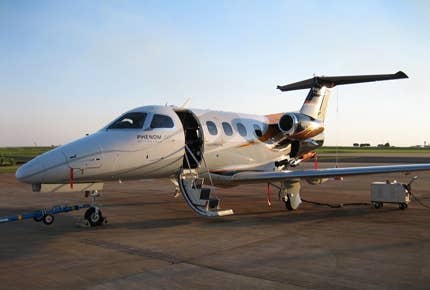
At first, there is only the faint whine of an accelerating jet engine against golden fields of sugarcane stretching out into the distance. Then, as the sound grows nearer, the sleek, compact shape of Embraer's new Phenom 100 jet appears, breaking ground for only the seventh time at the company's brand-new manufacturing and flight test facilities at Gavião Peixoto (Pe-show-toe), in the São Paulo region of Brazil.
The Phenom 100-a four-passenger very light jet (in a configuration that includes a private rear lavatory) with a projected cruise speed of 380 knots, an operating ceiling of 41,000 feet, an IFR range of 1,160 nm and a price of $2.98 million-is Embraer's second entry into the executive aircraft market and the company's first design created specifically for business aviation use. Embraer's Legacy 600, which debuted in 2001, is based on Embraer's ERJ 135 commercial regional jet, and the Lineage 1000, scheduled for its first delivery in mid-2008, is based on Embraer's larger 190 commercial airliner.
But the Phenom 100 and its bigger, seven-to-eight-passenger brother, the Phenom 300, scheduled for its first flight next summer, are clean-sheet designs-just like the airport at Gavião Peixoto, where both jets will be assembled and flight-tested. When Embraer bought the 4,184-acre plot of land in 2001, the property had nothing on it except sugarcane fields and orange groves. Six years and $72 million later, Gavião Peixoto has a 15,000-foot runway that's wide enough to play a regulation-size soccer match on, if one didn't care about the wear and tear on one's knees. It now also houses a defense hangar for Embraer's Super Tucano assembly and testing, one of seven maintenance centers Embraer is building around the world to service its Legacy and smaller executive aircraft (in addition to 38 non-Embraer-owned authorized service centers), Embraer's flight-test facilities-and, of course, assembly facilities for the new Phenom jets.
Right now, the Phenom assembly spaces are cavernous open areas with shiny white floors that still smell of fresh paint and new materials. But in a little over a month, the wings and fuselage of Phenom No. 3 will arrive here from Embraer's third factory in Botucatu, São Paulo, and the factory will kick into a production schedule that aims to turn out 120-150 Phenom jets a year by 2009.
It's an astounding accomplishment for a company that was on the brink of extinction in the early 1990s, with a backlog of only 20 aircraft orders and a workforce that had dwindled to less than 3,000. But the government-owned company was privatized in 1994, the new capital enabled production of the first Embraer regional jet and the company rebounded to its current position as Brazil's largest exporter, with net sales of over $3 billion/year since 2004, a current backlog of orders totaling $15.6 billion and more than 20,000 people employed across its three São Paulo locations.
Of course, Embraer's history also gives it some unique advantages as it works to expand into the business aviation market. For one thing, it has two established families of commercial aircraft (the ERJ 145 and the Embraer 170/190), with hundreds of thousands of proven flight hours and a readily available supply of spare parts, which gave Embraer two natural platforms for a super-midsize and an ultra-large-size executive aircraft. And while the Phenoms are a very different type and class of aircraft, they're still backed by the resources and facilities of the world's third-largest commercial aircraft manufacturer. In addition, Embraer is not saddled with vintage-era facilities or processes. The first two words of Portuguese I learned in my visit to the new Phenom facility were "composto" and "metál," as I was repeatedly reassured by a very earnest Brazilian engineer that the primary components of the Phenom's tail-the vertical and horizontal-really were constructed completely of riveted composite, except for the rudder and elevator attach points.
Yet, while its facilities and aircraft are unequivocally world-class, Embraer is still closely linked to the land and people of Brazil. The fact that the ultra-modern Gavião Peixoto facility is surrounded by fields of sugarcane, punctuated by tall plumes of black smoke where traditional farmers are burning the crop before harvest, seems incongruous, at first. But upon reflection, the juxtaposition seems more fitting than strange. For sugarcane is one of Brazil's most plentiful and important ingredients-not only for the Cachaça alcohol that fuels the national cocktail known as the "Caipirinha," but also for the ethanol that fuels many vehicles in Brazil-including some of Embraer's new aircraft.
Since 2005, the standard powerplant for Embraer's Ipanema crop duster planes, which it manufactures in its Botucatu facility, has been a modified Lycoming IO-540 engine that runs on ethanol fuel. (Embraer still offers a version of the airplane with an avgas-powered engine for customers who specifically request that option.)
Brazil as a country also faces some unique social and economic challenges, which affect Embraer, as well. According to Embraer's executive vice president for Executive Jets, Luis Carlos Affonso, part of the challenge is that Brazil transitioned in only 50 years from a country with a population that was 80 percent rural and 20 percent urban to a country with the exact opposite proportions.
"Pressure for social change is widespread in Brazil," agreed Luiz Sergio Cardoso de Oliveira, the Stanford-educated director of Embraer's social development programs. "There is rampant violence in the big cities ... and while Brazil achieved universal education 10 years ago, only 15-20 percent of those kids are receiving a really good education."
So as part of the company's social and environmental efforts, Embraer puts $3.6 million a year into a pilot school for bright but economically disadvantaged students from the communities around its main San Jose dos Campos facility. The school is a laboratory where Embraer is attempting to develop and test improved school management techniques and curriculum modules that might then be incorporated into São Paulo's ailing public school system.
But if Embraer's roots are unquestionably Brazilian, its reach and ambitions stretch clear around the world, with the goal of providing an increasing number of options for both business and commercial jet operators. The company recognizes the need for more global customer service in the executive aircraft market-hence Embraer's development of 45 Phenom/Legacy service centers across four continents. And while the company is still planning to deliver the new Phenoms at its São Paulo facility, senior managers are at least looking at possibly providing ferry flight services or other delivery options.
As Embraer's service and delivery options and network grows, so, too, may its family of executive jets. The eventual goal, according to Affonso, is for Executive Jets to comprise 20 percent of Embraer's total revenues-a goal that seems achievable, given that the section accounted for 15 percent of company revenues last year. But the company's commercial sector is growing as well. So keeping a 20 percent share of a growing pie will be a challenge, Affonso said-one that may be met by increasing the number of models Embraer produces for the Executive Jet market.
"There is room for at least two airplanes between the Phenom and the Legacy," acknowledged Affonso. "So that's what's next, but we have not decided yet." Stay tuned.

Sign-up for newsletters & special offers!
Get the latest FLYING stories & special offers delivered directly to your inbox






